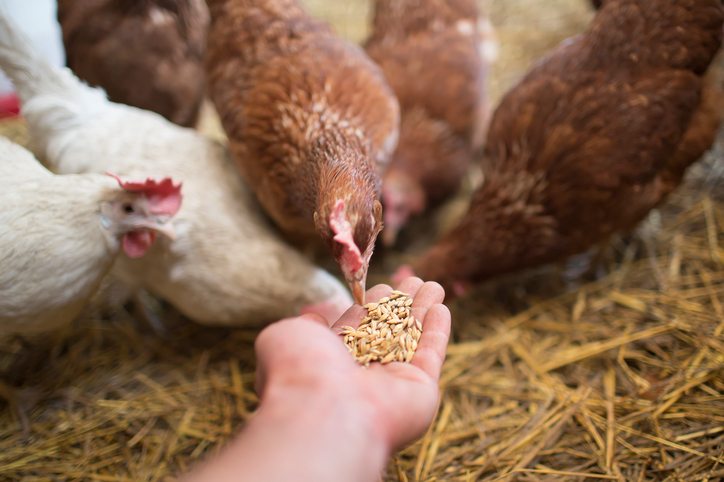For every poultry enthusiast, understanding how much grit to mix with chicken feed is crucial for maintaining healthy and happy chickens. Grit is an indispensable part of a chicken’s diet, aiding in digestion and overall well-being. Let’s delve into the details and provide you with approved tips for mixing grit with chicken feed.

The Importance of Grit in a Chicken’s Diet
Grit is vital for chickens as it helps grind down the feed they consume, enabling proper digestion and absorption of nutrients. Unlike mammals, chickens don’t have teeth to chew their food. Instead, they rely on their gizzards, and this is where grit plays a critical role. Proper digestion leads to healthy growth and improved egg production. Moreover, understanding how much grit to mix with chicken feed can prevent digestive issues and keep your flock in top condition.

Types of Grit: Insoluble and Soluble
There are two primary types of grit: insoluable and solube. Insoluble grit, like granite, remains in the gizzard for grinding food. Soluble grit, such as oyster shells, dissolves and provides essential minerals like calcium.
Insoluble Grit
Insoluble grit is essential for grinding down grains and other feed. It’s made from hard substances like granite. This type of grit stays in the gizzard for a long time and is continuously used to grind food.
Soluble Grit
Soluble grit, mainly composed of oyster shells or limestone, provides additional nutrients like calcium, essential for eggshell production. This type of grit dissolves in the hen’s digestive system and needs to be replenished regularly.

Mixing Grit with Chicken Feed: The Approved Ratio
The approved ratio of mixing grit with chicken feed largely depends on the type and age of your chickens. For adult chickens, a recommended ratio is about 1-2 pounds of grit per 50 pounds of feed. For younger chickens, the amount of grit should be halved, as they require less grit for their smaller gizzards.

Step-by-Step Guide on Mixing Grit with Chicken Feed
Step 1: Determine the Feed Quantity
Start by determining the amount of feed your chickens consume weekly. This helps in calculating how much grit to mix.
Step 2: Measure the Grit
Using a scale, measure the appropriate amount of grit based on the feed quantity. As mentioned, for every 50 pounds of feed, use about 1-2 pounds of grit.
Step 3: Mix Thoroughly
Ensure to mix the grit evenly with the feed. This ensures that each chicken gets a fair share of grit with every meal.
Step 4: Monitor and Adjust
Keep an eye on your flock’s health and digestion. If you notice any digestive issues, you may need to adjust the amount of grit accordingly.
Common Questions About Grit and Chicken Feed
Can Chickens Eat Too Much Grit?
While grit is essential, it’s possible for chickens to consume too much, which can lead to digestive problems. Always adhere to the recommended ratios to ensure your flock’s health.
What Happens if Chickens Don’t Get Enough Grit?
Failure to provide adequate grit can result in digestive issues, poor nutrient absorption, and ultimately, a drop in egg production. Ensuring the right amount of grit is mixed with their feed is crucial.
Benefits of Using Grit in Chicken Feed
There are multiple benefits to including grit in chicken feed. Firstly, it aids in the mechanical digestion of feed, leading to better nutrient absorption. Secondly, chickens that consume grit regularly have stronger, healthier gizzards.
Enhanced Egg Production
For laying hens, soluble grit provides essential calcium, leading to stronger eggshells and overall better egg production.
Improved Overall Health
Regular intake of grit ensures that chickens maintain good digestive health, leading to a healthier and more robust flock.
Alternatives to Grit
While grit is highly recommended, there are some alternatives you can consider. These alternatives might not be as effective but can serve as a temporary solution.
Sand
Sand can be a temporary substitute for insoluble grit. However, its important to note that sand dissolves faster than granite, making it less effective in the long run.
Eggshells
Crushed eggshells can be a good source of calcium, similar to soluble grit. However, it is not a complete replacement for all the benefits of gritty substances.
Conclusion
Understanding how much grit to mix with chicken feed is crucial to maintaining a healthy and productive flock. By following the approved ratios and guidelines, you can ensure that your chickens get the necessary nutrients and keep their digestion on track. Empower yourself with the knowledge of proper grit use, and you’ll be delighted with the tremendous results in your poultry’s health and egg production.
FAQ
Is grit necessary for all types of feed?
Yes, whether your chickens are consuming grains, pellets, or mixed feed, grit is essential for proper digestion.
How often should I replenish grit?
Grit should be replenished regularly, especially soluble grit, as it dissolves and exits the digestive system quickly.
Can I provide grit free-choice?
Yes, offering grit in a separate dish is an excellent way for chickens to self-regulate their intake as needed.
As an Amazon Associate, I earn from qualifying purchases.









